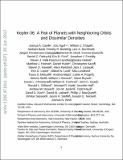Kepler-36: A Pair of Planets with Neighboring Orbits and Dissimilar Densities
Author(s)
Deck, Katherine M.; Winn, Joshua Nathan; Rogers, Leslie Anne
DownloadWinn_Kepler-36.pdf (5.447Mb)
PUBLISHER_POLICY
Publisher Policy
Article is made available in accordance with the publisher's policy and may be subject to US copyright law. Please refer to the publisher's site for terms of use.
Terms of use
Metadata
Show full item recordAbstract
In the solar system, the planets’ compositions vary with orbital distance, with rocky planets in close orbits and lower-density gas giants in wider orbits. The detection of close-in giant planets around other stars was the first clue that this pattern is not universal and that planets’ orbits can change substantially after their formation. Here, we report another violation of the orbit-composition pattern: two planets orbiting the same star with orbital distances differing by only 10% and densities differing by a factor of 8. One planet is likely a rocky “super-Earth,” whereas the other is more akin to Neptune. These planets are 20 times more closely spaced and have a larger density contrast than any adjacent pair of planets in the solar system.
Date issued
2012-06Department
Massachusetts Institute of Technology. Department of Physics; MIT Kavli Institute for Astrophysics and Space ResearchJournal
Science
Publisher
American Association for the Advancement of Science (AAAS)
Citation
Carter, J. A., E. Agol, W. J. Chaplin, S. Basu, T. R. Bedding, L. A. Buchhave, J. Christensen-Dalsgaard, et al. “Kepler-36: A Pair of Planets with Neighboring Orbits and Dissimilar Densities.” Science 337, no. 6094 (June 21, 2012): 556–559.
Version: Author's final manuscript
ISSN
0036-8075
1095-9203